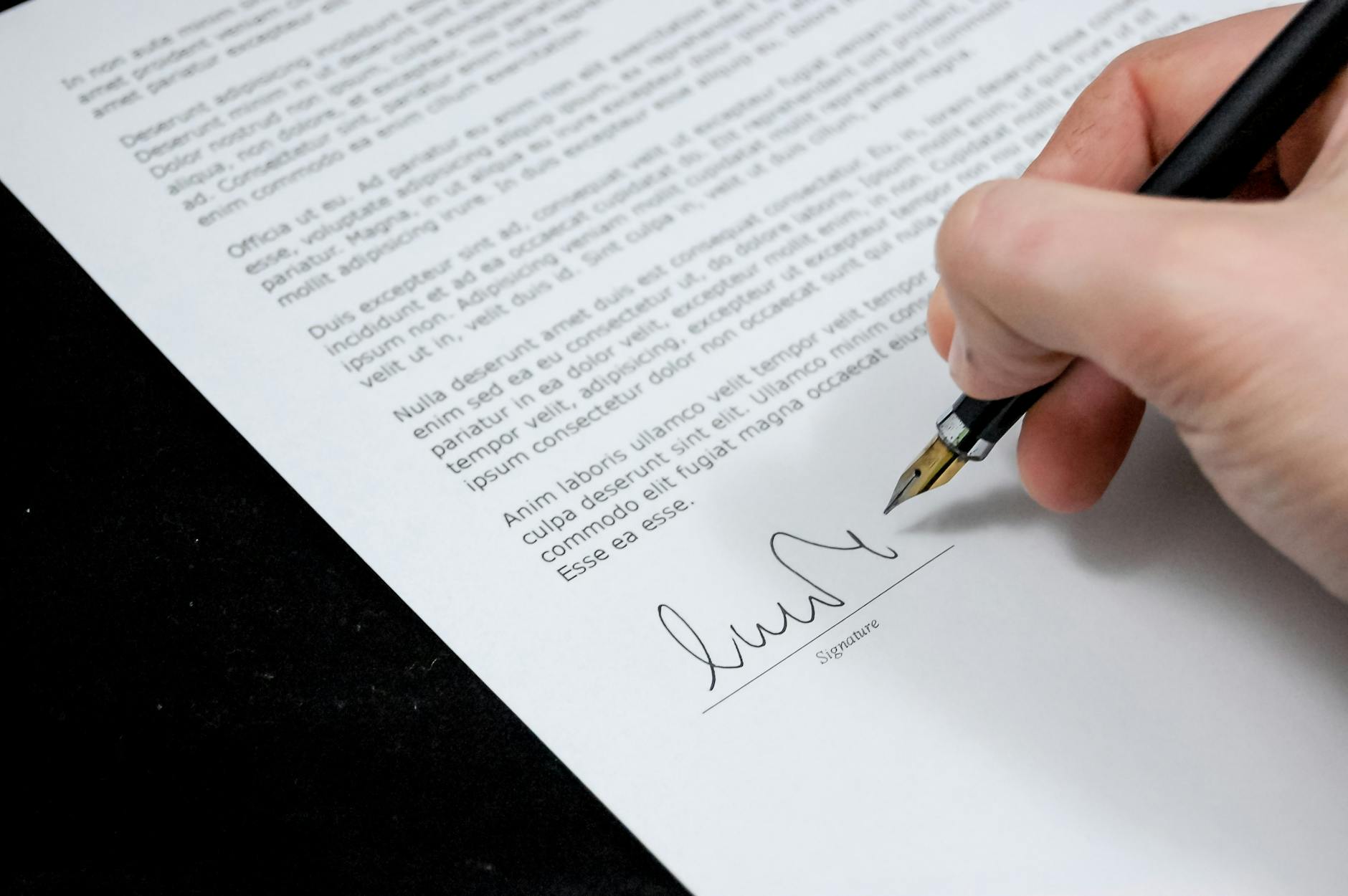In this post, I invite readers to explore how e-signature platforms effectively integrate with a framework of laws and regulations. These platforms ensure that digital transactions aren’t just fast, but also exhibit strong legal compliance. As e-signatures gain traction, understanding their legal implications becomes crucial for both personal finance and business sectors.
Understanding E-signatures
The concept of an electronic signature, often referred to as an e-signature, may sound trivial but it’s quite revolutionary. More than just scribbles on a screen, e-signatures stand as legal affirmations facilitating modern-day transactions. They are integral to digitizing traditional processes, reducing paperwork, and supporting legal compliance in various sectors. But what makes these symbols legitimate or more importantly – legally binding? Here’s a breakdown of their components and variations, crucial for anyone navigating digital interactions and transactions.

What is an E-signature?
In its simplest form, an e-signature is a digital mark included in a document signaling intent to sign. Think of it as the modern-day counterpart of hand-written signatures. These signatures rely on unique identifiers — like click-wrap agreements — to establish an agreement and are upheld by most jurisdictions solidifying their place as credible legal tools. Interestingly, an e-signature doesn’t necessarily need to resemble your actual signature as it encompasses a wide range of technologies, from a simple scanned image to complex encoded data linked to the signees. The pivotal factor is not the aesthetic of the signature but the intent behind it and its ability to reflect the legitimacy of the agreement learn more about what is legally binding and enforceable.
Types of E-signatures
Just like physical signatures weren’t one-size-fits-all, e-signatures come with their tiers. Understanding these types aids in selecting fit-for-purpose methods while staying compliant with regulations surrounding electronic transactions.
- Simple Electronic Signatures (SES): The most common, these might include symbols like an initial checkbox or a scanned handwritten signature. They serve well for low-risk engagements where straightforward authenticity suffices and legal challenges are less likely.
- Advanced Electronic Signatures (AES): With more rigorous authentication processes, AES offers greater security assurances. These require verification of identity, providing mechanisms that ensure the signature’s integrity so it emanates from who it purports to be.
- Qualified Electronic Signatures (QES): The elite of e-signatures, bearing the closest semblance to handwritten signatures. These are supported by a qualified certificate created by a qualified electronic signature device assuring the highest level of surety in significant transactions or sensitive sectors. Regulatory frameworks often consider them on par with ink signatures due to their robust infrastructure. How do these interact with local laws? Dive into detailed compliance requirements here.
Each type of e-signature affords varying levels of security and legal standing determined largely by the compliance protocols surrounding digital identity safeguards.
Keen to elevate your financial fluency alongside digital fluency? Consider exploring further banking articles or subscribing to gain insight into fast financial terrain transformations aligned with digital advancements.
Legal Framework Surrounding E-signatures
Electronic signatures, or e-signatures, carry significant legal weight in our fast-moving digital world. These digital marks are not just about convenience; they’re intensively regulated, ensuring that online transactions stay legally sound. Entering into agreements online has become commonplace, but what dives beneath that tap of a screen rests firmly on the sturdy foundations of legal frameworks like the ESIGN Act and UETA. Let’s dig into how these things make your clicks count.

ESIGN Act
The Electronic Signatures in Global and National Commerce Act, or ESIGN Act, became law in the year 2000. This pivotal legislation gave official acknowledgment that electronic signatures hold the same legal weight as their inked counterparts. What this did was quite revolutionary: it threw open the doors to e-commerce by ensuring e-signatures could stand in court beside traditional paper signatures.
This act means most contracts – be it on real estate or banking explore more on bank compliance – could be finalized without a drop of ink. So why do paper-tied obligations even? With federal backing, e-signatures now riding high on the list of convenient, binding tools for modern agreements.
UETA
The Uniform Electronic Transactions Act, or UETA, complements the powers of the ESIGN Act on a state level. Created in 1999, this act gave states a skeleton on which to build their digital transaction laws, thereby making electronic records and signatures as legally valid as those in physical form. While the ESIGN Act covers the federal scope, UETA gives jurisdictions within states a base to enact tailored rules for practical digital business within their borders and learn about nuances.
The beauty of UETA is its flexibility. States can tweak these regulations for nuanced applicability, creating a uniform yet diverse legal platform. So when you’re signing that digital lease or closing a loan on the go, take comfort that UETA has laid the groundwork for robust electronic deals.
Incorporating State Laws
When diving into the realm of e-signatures, remember that while the ESIGN Act and UETA create a solid federal-state bridge, every state might paint its picture using varying strokes governed by individual needs. Some states have their quirks, like California’s consumer protection angle, or New York’s reluctance initially to leap onto the UETA bandwagon, opting for similar legis framework named the Electronic Signatures and Records Act. Yes, state laws might color outside UETA’s outlines, requiring us to be observant.
Crucially, navigating all these could appear as though you are on a giant legal map where paths occasionally diverge yet converge again thanks to the major roads built by federal acts. Like trying to beat the satnav of digital agreements – stay vigilant, know the general laws, but tune in sometimes when state-specific regulations play out!
E-signature platforms are like GPS which charts a lawful course using ESIGN and UETA as major highways, while state laws craft those neat little shortcuts or sometimes detours that align with local demands to discover more guideposts.
Eager to explore more and ensure that you are on the right legal path for digital transactions? Discover new insights here. And if keeping an eye on your finances or getting banking tips makes you as curious as ever, subscribing will connect you to financial fortitude and safe signature skies!
Impact on Business Transactions
E-signature platforms are transforming how businesses conduct transactions, offering not just convenience but also aligning with stringent legal requirements. As digital fields spread their influence, these platforms prove to be a key element in ensuring businesses remain efficient and legally compliant in their operations.

Efficiency and Speed
Imagine sealing a business deal without the endless chain of paperwork. E-signatures trim down all that excess, acting as the metaphorical scissors to cut through bureaucratic red tape. By facilitating instant signing, they accelerate operations significantly, trimming what can be days off traditional timelines. For instance, businesses utilizing platforms like DocuSign or Adobe Sign find themselves bolstered by the rapid patina of instant verification processes. This not only keeps operations swift but also markets businesses as digitally savvy frontrunners.
Explore more in-depth the importance of adopting an e-signature policy.
Security Measures
Yet, with speed, security can’t be left behind; it’s the sturdy lock on a fast-moving vehicle. E-signatures come equipped with an array of security features akin to digital bodyguards ensuring that each document remains confidential and inaccessible to unauthorized individuals. Common features include encryption, authentication protocols, audit trails that verify signer identities, and signer location tracking. These measures are essential to fortify trust and certainty, maintaining the integrity of business transactions that otherwise traverse unsecured digital landscapes.
Understand more about how e-signatures channel legal safety nets via ESIGN Act frameworks.
Cost-effectiveness
On the other side of the financial canvas, e-signatures are the efficient artists minimizing administrative costs. There’s a noticeable reduction in expenditures otherwise spent on paper, printing, shipping, and storage. Companies benefit from substantial savings when they switch to digital alternatives, reallocating these funds to areas like employee development or product innovation. Beyond material savings, these tools pave sustainability and corporate responsibility paths, painting a broader, harmonious business outlook focused on more than just the bottom line.
Discover how to integrate such efficiency features within small business structures.
Navigate further into a world where banking compliance intertwines with trending technological tokens. Excited for more? Enhance your digital financial perspective with our curated financial education resources and consider subscribing for the latest scoops connecting you effortlessly to the pulse of fiscal advancements.
E-signatures and Compliance Issues
Navigating the landscape of e-signature platforms in conjunction with legal compliance is an intriguing odyssey. In our increasingly digital world, ensuring that e-signatures align with various laws isn’t merely about box-ticking – it’s a strategic necessity. These electronic markings aren’t just novel; they pack formidable legal power when executed with best practices ensuring security and legitimacy. As we wade into this topic, let’s drill into best practices and address industry-specific needs.
Ensuring Validity and Legality
To render e-signatures as valid as your cherished signature on paper, it’s vital to follow best practices. Electronic signatures, governed by frameworks such as the ESIGN Act, carry the same legal potency as their pen-and-paper cousins. But how do we ensure they remain bulletproof? Let’s explore:
- Consent & Intent: Always verify that users consent to use electronic methods and that intent to sign, in any scenario, is clear.
- Authentication: Know who you’re dealing with. Use access controls and identity verification measures.
- Document Integrity: Ensure the document hasn’t been altered post-signing by employing systems retaining the original state of signed documents.
- Audit Trails: Implement thorough audit trails reflecting every click and agreement to bolster legal defensibility.
- Understanding Local Laws: While the ESIGN Act provides a solid base, geographical nuances demand awareness of local instruments like UETA.
Employing these strategies not only safeguards legality but streamlines e-signature integration into everyday business, digitalizing processes without sacrificing legal rigor.

Industry-specific Compliance
Certain sectors demand specialized scrutiny owing to tailored legal prerequisites. Understanding these unique compliance mandates helps preempt risks and optimizes process alignment.
- Finance: In industries similar to banking, stringent rules clarify document retention and data protection compliant with legislation like SOX. Financial institutions can navigate these more effectively, staying tuned to bank compliance tips and secure measures particular to the financial terrain.
- Healthcare: Non-compliance in human-centric spheres such as healthcare invites dire implications. According to HIPAA, for instance, HIPAA-compliant e-signatures not only secure patient data but stabilize operational transparency.
Adapting to sector-specific statutes ensures smooth business operations, minimizing hurdles related to inconsistency or regulatory lapses. From financial realms to healthcare spheres, calibrating e-signature deployment by comprehending industry lexicons enhances compliance mastery.
The nexus of e-signatures and compliance gives businesses a clear digital route, confirming their electronic documentation is as unequivocal as traditional formats. Follow through our banking articles for diving into details that could help future-proof your operational strategies. Join us and let’s traverse smarter financial paths together!
The Future of E-signatures
In the ever-evolving world of digital transactions, e-signatures continue to gain traction as essential tools for seamless, efficient, and legally compliant processes. As I look toward the future, several technological trends and global market adoption patterns will shape the role of e-signatures in everyday transactions.
Technological Advances: Consider how technology will further change the use of e-signatures.
Technological innovation shows no sign of slowing, and e-signatures are riding the wave toward greater efficiency and security. Imagine a world where signing documents could become as intuitive as unlocking your smartphone. With trends like advanced authentication and blockchain utilization pushing the boundaries, e-signatures are set to become even more seamless. For instance, integrating biometric data (such as fingerprints or facial recognition) can ensure that signatures are not only swift but airtight in terms of identity verification.
Moreover, as internet access becomes more widespread, there’s an expected surge in mobile-first solutions. This ensures that conducting business no longer remains confined to office desktops but extends to handheld devices, bolstering versatility in signing processes. Technology, by encouraging sustainable practices, promises decreased dependency on paper – a massive win for eco-conscious enterprises bent on intertwining efficiency with responsibility.

E-signatures in Global Markets: Explore how e-signatures are being adopted in international markets.
Globally, e-signatures tilt toward becoming the universal language of digital consent. The adoption of e-signatures varies between regions, driven largely by local laws, digital infrastructure, and business norms. For instance, in parts of Asia and Europe, stringent legal frameworks support e-signature usage, actively embraced by businesses aiming to break barriers in a digitized economy source.
Africa and Latin America, too, are partaking in this digital transformation journey, convincing local enterprises of the economic benefits brought by e-signatures. As regulatory standards improve and technology indiscriminately spreads its influence, more nations are expected to adopt these solutions, leveling the playing field in global commerce. It’s almost like watching a digital symphony unfold where, regardless of geographic discord or economic cacophony, e-signatures find harmony universally.
In the cross-currents of regulation changes, diverse regions are seamlessly aligning within international trade codes, opening up portals for cross-border agreements fortified by e-signatures. As such, it stands to reason that entities can consolidate efforts toward cohesion in global digital operations, granting more security in trade deals spanning borders.
What next could revolutionize your financial horizons? Begin your exploration of these intriguing bends with more articles in our banking section by subscribing today, joining a community engaged in carving tomorrow’s digital financial pathways.
Further Considerations in E-signatures and Compliance
As I explore the crucial intersection between e-signatures and compliance, I realize that rigor in this area is anything but optional. E-signatures have revolutionized business transactions, contributing to speed and efficiency across sectors. However, with this innovation emerges a pressing need to navigate the complex landscape of legal considerations surrounding digital agreements. From the foundational ESIGN Act to state-specific regulations, understanding these pathways is key.

Interplay with Financial Regulations
E-signatures aren’t simply about modernization; they’re entangled with various financial regulations. Each time I electronically sign a document, I’m not just engaging in convenience—I’m making a momentous statement that combines technology with compliance. For banking institutions, these signatures must align with federal regulations, often informed by guidelines found in banking compliance articles.
- Electronic Signatures in Global and National Commerce Act (ESIGN): This pivotal law ensures the legality of electronic signatures on financial documents, paving the way for seamless digital transactions.
- UETA Compliance: Many states have their governing bodies that dictate how electronic agreements should occur on state levels. It’s essential to stay informed about local regulations.
Industry Implications
In sectors like healthcare and finance, e-signatures have specific implications because of their sensitive nature. When practicing e-signatures in healthcare, the stakes rise; compliance with HIPAA regulations demands strong security measures.
- Access Controls: Healthcare professionals must ensure that e-signatures retain patient confidentiality while recognizing a patient’s authority to consent.
- Financial Institutions: Banks find e-signatures critical, especially in streamlining processes like loan applications or account openings, which involve massive paperwork in traditional settings. Staying ahead of legal changes is equally important, as financial trends shift rapidly.
E-signatures represent a bridge that leads to effective management while making a compliant transition away from paper trails.
Best Practices for Implementation
Adapting e-signatures requires an understanding of best practices alongside compliance requirements. Here are some practices to consider:
- Consistent Training: Ensure your team is trained in best practices for implementing e-signatures effectively. Creating a culture centered on understanding compliance not only protects the organization but also builds confidence in staff.
- Robust Digital Infrastructure: Utilize secure platforms that provide authentication verification. International e-signature platforms should comply with international standards, offering peace of mind through visibility into transactions.
As I consider these countermeasures, it affirms for me that e-signatures can only be robust when grounded in law.
For more on how these frameworks impact modern banking or to explore specifics about financial compliance, I recommend checking out related resources in our banking section.
In this rapidly adapting world, knowing the legal landscape isn’t just empowering. It may well be your best protection as you navigate e-signatures, compliance, and the future of making transactions. Interested in refining your financial strategies? Join me, and explore more enlightening articles in our financial guides.
Leave a Reply